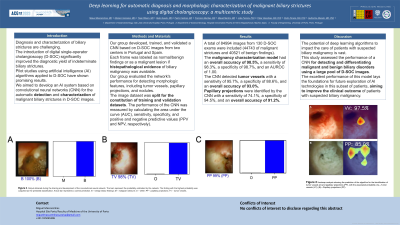Sunday Poster Session
Category: Biliary/Pancreas
P0001 - Deep Learning for Automatic Diagnosis and Morphologic Characterization of Malignant Biliary Strictures Using Digital Cholangioscopy: A Multicentric Study
Sunday, October 22, 2023
3:30 PM - 7:00 PM PT
Location: Exhibit Hall

Has Audio

Miguel Mascarenhas, MD
Centro Hospitalar São João
Porto, Porto, Portugal
Presenting Author(s)
Award: Presidential Poster Award
Miguel Mascarenhas, MD1, Mariano Gonzalez, MD2, Tiago Ribeiro, MD1, Belen Agudo, MD2, Pedro Cardoso, MD1, Francisco Mendes, MD1, Miguel Martins, MD1, João Ferreira, PhD3, Filipe Vilas-Boas, MD, PhD4, Pedro Pereira, MD, PhD1, Guilherme Macedo, MD, PhD5
1Centro Hospitalar São João, Porto, Porto, Portugal; 2Hospital Universitario Puerta de Hierro Majadahonda, Madrid, Madrid, Spain; 3University of Porto-FEUP, Porto, Porto, Portugal; 4Centro Hospitalar Universitário de São João, Porto, Porto, Portugal; 5Centro Hospitalar de São João, Porto, Porto, Portugal
Introduction: Diagnosis and characterization of biliary strictures are challenging. The introduction of digital single-operator cholangioscopy (D-SOC) significantly improved the diagnostic yield of indeterminate biliary strictures. Pilot studies using artificial intelligence (AI) algorithms applied to D-SOC have shown promising results. We aimed to develop an AI system based on convolutional neural networks (CNN) for the automatic detection and characterization of malignant biliary strictures in D-SOC images.
Methods: Our group developed, trained, and validated a CNN based on D-SOC images from two centers in Portugal and Spain. Each frame was labeled as normal/benign findings or as a malignant lesion if histopathological evidence of biliary malignancy was available. Also, we evaluated the network's performance for detecting morphologic features, including tumor vessels, papillary projections, and nodules. The image dataset was split for the constitution of training and validation datasets. The performance of the CNN was measured by calculating the area under the curve (AUC), sensitivity, specificity, and positive and negative predictive values (PPV and NPV, respectively).
Results: A total of 84994 images from 130 D-SOC exams were included (44743 of malignant strictures and 40521 of benign findings). The model had an overall accuracy of 98.3%, a sensitivity of 98.3%, a specificity of 98.3%, and an AUROC of 1.00.
Our group evaluated the performance of the CNN for the detection of morphological characteristics associated with malignancy, particularly tumor vessels and papillary projection. The CNN detected tumor vessels with a sensitivity of 95.7%, a specificity of 88.6%, and an overall accuracy of 93.0%. Papillary projections were identified by the CNN with a sensitivity of 74.1%, a specificity of 94.5%, and an overall accuracy of 91.2%.
Discussion: The potential of deep learning algorithms to impact the care of patients with suspected biliary malignancy is vast. This study assessed the performance of a CNN for detecting and differentiating malignant and benign biliary disorders using a large pool of D-SOC images. The excellent performance of this model lays the foundations for future exploration of AI technologies in this subset of patients, aiming to improve the clinical outcome of patients with suspected biliary malignancy.

Disclosures:
Miguel Mascarenhas, MD1, Mariano Gonzalez, MD2, Tiago Ribeiro, MD1, Belen Agudo, MD2, Pedro Cardoso, MD1, Francisco Mendes, MD1, Miguel Martins, MD1, João Ferreira, PhD3, Filipe Vilas-Boas, MD, PhD4, Pedro Pereira, MD, PhD1, Guilherme Macedo, MD, PhD5. P0001 - Deep Learning for Automatic Diagnosis and Morphologic Characterization of Malignant Biliary Strictures Using Digital Cholangioscopy: A Multicentric Study, ACG 2023 Annual Scientific Meeting Abstracts. Vancouver, BC, Canada: American College of Gastroenterology.
Miguel Mascarenhas, MD1, Mariano Gonzalez, MD2, Tiago Ribeiro, MD1, Belen Agudo, MD2, Pedro Cardoso, MD1, Francisco Mendes, MD1, Miguel Martins, MD1, João Ferreira, PhD3, Filipe Vilas-Boas, MD, PhD4, Pedro Pereira, MD, PhD1, Guilherme Macedo, MD, PhD5
1Centro Hospitalar São João, Porto, Porto, Portugal; 2Hospital Universitario Puerta de Hierro Majadahonda, Madrid, Madrid, Spain; 3University of Porto-FEUP, Porto, Porto, Portugal; 4Centro Hospitalar Universitário de São João, Porto, Porto, Portugal; 5Centro Hospitalar de São João, Porto, Porto, Portugal
Introduction: Diagnosis and characterization of biliary strictures are challenging. The introduction of digital single-operator cholangioscopy (D-SOC) significantly improved the diagnostic yield of indeterminate biliary strictures. Pilot studies using artificial intelligence (AI) algorithms applied to D-SOC have shown promising results. We aimed to develop an AI system based on convolutional neural networks (CNN) for the automatic detection and characterization of malignant biliary strictures in D-SOC images.
Methods: Our group developed, trained, and validated a CNN based on D-SOC images from two centers in Portugal and Spain. Each frame was labeled as normal/benign findings or as a malignant lesion if histopathological evidence of biliary malignancy was available. Also, we evaluated the network's performance for detecting morphologic features, including tumor vessels, papillary projections, and nodules. The image dataset was split for the constitution of training and validation datasets. The performance of the CNN was measured by calculating the area under the curve (AUC), sensitivity, specificity, and positive and negative predictive values (PPV and NPV, respectively).
Results: A total of 84994 images from 130 D-SOC exams were included (44743 of malignant strictures and 40521 of benign findings). The model had an overall accuracy of 98.3%, a sensitivity of 98.3%, a specificity of 98.3%, and an AUROC of 1.00.
Our group evaluated the performance of the CNN for the detection of morphological characteristics associated with malignancy, particularly tumor vessels and papillary projection. The CNN detected tumor vessels with a sensitivity of 95.7%, a specificity of 88.6%, and an overall accuracy of 93.0%. Papillary projections were identified by the CNN with a sensitivity of 74.1%, a specificity of 94.5%, and an overall accuracy of 91.2%.
Discussion: The potential of deep learning algorithms to impact the care of patients with suspected biliary malignancy is vast. This study assessed the performance of a CNN for detecting and differentiating malignant and benign biliary disorders using a large pool of D-SOC images. The excellent performance of this model lays the foundations for future exploration of AI technologies in this subset of patients, aiming to improve the clinical outcome of patients with suspected biliary malignancy.

Figure: Fig.1 Output obtained during the training and development of the convolutional neural network. The bars represent the probability estimated by the network. The finding with the highest probability was outputted as the predicted classification. A blue bar represents a correct prediction. B – benign biliary findings; M – malignant stricture; O – Other; PP – papillary projections; TV – tumor vessels.
Disclosures:
Miguel Mascarenhas indicated no relevant financial relationships.
Mariano Gonzalez indicated no relevant financial relationships.
Tiago Ribeiro indicated no relevant financial relationships.
Belen Agudo indicated no relevant financial relationships.
Pedro Cardoso indicated no relevant financial relationships.
Francisco Mendes indicated no relevant financial relationships.
Miguel Martins indicated no relevant financial relationships.
João Ferreira indicated no relevant financial relationships.
Filipe Vilas-Boas indicated no relevant financial relationships.
Pedro Pereira indicated no relevant financial relationships.
Guilherme Macedo indicated no relevant financial relationships.
Miguel Mascarenhas, MD1, Mariano Gonzalez, MD2, Tiago Ribeiro, MD1, Belen Agudo, MD2, Pedro Cardoso, MD1, Francisco Mendes, MD1, Miguel Martins, MD1, João Ferreira, PhD3, Filipe Vilas-Boas, MD, PhD4, Pedro Pereira, MD, PhD1, Guilherme Macedo, MD, PhD5. P0001 - Deep Learning for Automatic Diagnosis and Morphologic Characterization of Malignant Biliary Strictures Using Digital Cholangioscopy: A Multicentric Study, ACG 2023 Annual Scientific Meeting Abstracts. Vancouver, BC, Canada: American College of Gastroenterology.

